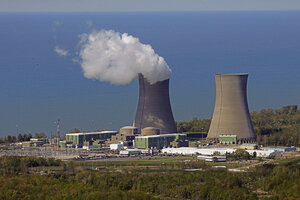Is nuclear fusion power now possible?
The quest for nuclear fusion power is well known, Daly writes, having been around since the dawn of the nuclear age, but the physics have precluded significant research. Until now.

The Perry Nuclear Power Plant is shown on the shore of Lake Erie in North Perry, Ohio. Another aspect of potential nuclear power generation from the atom seems poised to take a giant leap forward, Daly writes, with potentially enormous implications for the entire issue of civilian nuclear power generation.
Mark Duncan/AP/File
On 26 April, the world largely yawned as a nuclear anniversary came and went.
Twenty-seven years ago, the Ukrainian SSR nuclear power plant at Chernobyl exploded, providing a severe test of the USSR’s General Secretary of the Communist Party Mihail Gorbachev’s policy of “glasnost” (“openness,”), which the sclerotic Soviet leadership signally failed, providing a less than candid drip feed of news about the magnitude of the disaster.
Nothing to see here, move along.
Twenty-five years later, Tokyo Electric Power Co.’s six reactor Fukushima Daiichi NPP was decimated by a tsunami generated by the offshore Tohoku earthquake in the western Pacific, estimated at 9.0 on the Richter scale.
Response?
Nothing to see here, move along, yet again.
What even the strongest proponents of civilian nuclear power production cannot deny is that both incidents released radioactive material into the surrounding environment, whose long-term environmental and human health consequences have yet to be seen. (Related article: NASA Funds Research into Fusion Powered Rocket for Deep Space Travel)
But the Chernobyl catastrophe is not forgotten in Ukraine, where last month Ukrainian Minister Mykola Azarov participated in commemorative events of the accident, which released radiation equivalent to 500 Hiroshima atomic bombs, while President Viktor Yanukovych said the total cost of the incident for his country over the last 27 years has been almost $180 billion.
But now, another aspect of potential nuclear power generation from the atom seems poised to take a giant leap forward, with potentially enormous implications for the entire issue of civilian nuclear power generation.
The potential way out?
Nuclear fusion, which instead of using the heat from breaking apart radioactive elements and isotopes to use the resultant temperatures to drive steam powered turbines, would instead attempt to reproduce the nuclear processes fueling stars to generate power instead from the fusion energy generated by lighter elements combining.
The quest is well known, having been around since the dawn of the nuclear age, but the physics have precluded significant research.
Until now.
A tokamak uses an intensive magnetic field to confine a plasma in the shape of a torus, which was were invented in the 1950s by Soviet physicists Igor Tamm and (later Nobel Peace Prize Laureate) Andrei Sakharov, inspired by the research of Oleg Lavrentiev. For the past five decades, the tokamak is the most-researched magnetic confinement device candidates for producing controlled thermonuclear fusion power, as magnetic fields are currently the best candidate for plasma confinement since no solid material could withstand the plasma’s extremely high temperatures. (Related article: The Coming Nuclear Waste Disaster)
And now, 34 nations are collaborating in the world’s largest scientific collaboration since the International Space Station to construct the $16.9 billion ITER (“International Thermonuclear Experimental Reactor”) fusion power project In Provence’s Cadarache forest in southern France.
Sidestepping previous research bottlenecks, where experimental tokamak fusion reactors devoured more power than they produced, the ITER fusion reactor has been designed to produce 500 megawatts of output power for 50 megawatts of input power. ITER’s construction of the facility began in 2007, and the first plasma is expected to be produced in 2020.
What is the appeal then of ITER?
Its hydrogen isotope fuels are relatively abundant, and its fuel isotopes, deuterium, can be extracted from seawater, while its tritium isotope could be created using neutrons produced in the fusion reaction itself. Like its NPPs predecessors, a fusion reactor would produce virtually no CO2 or other atmospheric pollutants, but, unlike its Three Mile Island, Chernobyl or Fukushima antecedents, its radioactive waste by products would be very short-lived compared to those produced by conventional nuclear reactors.
Given the depth of international commitment, one should not write off the possibility of success, as it involves top nuclear minds worldwide. In this context, it is worth remembering that America’s World War Two “Manhattan Project,” was an effort while, funded by Washington, involved emigre European scientists. What is the potential of a global effort of the “best and brightest, not only from the U.S. but Europe, Russia and Asia as well?
Original article: http://oilprice.com/Alternative-Energy/Nuclear-Power/Nuclear-Fusion-Possible-at-Last.html

